|
|
|
|
Late Entries to a Survey of Bestiaries
The staff of the Poison Pie Publishing House assembled a survey of one hundred bestiaries, posting an entry on their blog for each day from June 1, 2016 to September 8, 2016. When they were done, there were additional bestiaries that they did not want to omit entirely. This page lists latecomers to the survey added monthly in 2023.
|
|
|
|
|
January 7, 2023
The Botanical Bestiary
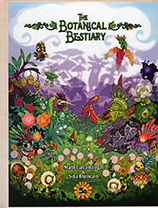 authors: Matt Cavanaugh
authors: Matt Cavanaugh
interior artists: Sita Duncan
cover artist: Sita Duncan
publisher: Inky Cap Press
publication date: December, 2022
cover: hardcover
number of pages: 76
ISBN-10: 0-01-157455-0
ISBN-13: 2-370011-574554
description: This bestiary contains descriptions of 65 leshies, each based on a different type of plant. It is compatible with the 5th edition of the Dungeons & Dragons Role Playing Game.
Our featured entry from this bestiary is the aloe leshy.
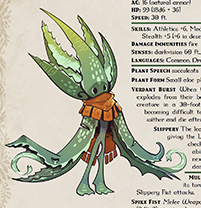 Originating from the Arabian Peninsula, the 500 species of aloe can now
be found growing almost anywhere warm. Aloe is a succulent, with gel filled
leaves capable of storing large amounts of water. These leaves have been
used for millennia as treatment for skin damage, especially sunburns and
minor irritation, and aloe is commonly cultivated for its gel and latex.
Originating from the Arabian Peninsula, the 500 species of aloe can now
be found growing almost anywhere warm. Aloe is a succulent, with gel filled
leaves capable of storing large amounts of water. These leaves have been
used for millennia as treatment for skin damage, especially sunburns and
minor irritation, and aloe is commonly cultivated for its gel and latex.
Typically found in desert and tropical environments, Aloe Leshies function
as healers in small settlements, soothing minor injuries with traditional
remedies. If provoked, the Aloe Leshy will leave enemies slipping, sliding,
and open to attack from its spiky leaves. Enhanced water-retention affords
a strong protection against the heat, both natural and magical in origin.
|
|
|
|
|
February 4, 2023
Boo's Astral Menagerie
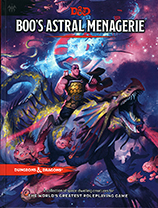 lead designer: Christopher Perkins
lead designer: Christopher Perkins
interior artists Zoltan Boros et al.
cover artists: Justin Gerard
publisher: Wizards of the Coast
publication date: 2022
cover: hardcover
number of pages: 64
ISBN-10: 0-7869-6816-8
ISBN-13: 978-0-7869-6816-9
description: This book was part of the Spelljammer: Adventures in Space set that also included Astral Adventurer's Guide rulebook, Light of Xaryxis adventure, a dungeon master's screen and a slipcase. This bestiary contains more than sixty space-dwelling creatures. This book is compatible with the 5th edition of the Dungeons & Dragons Role Playing Game.
Our featured entry from this bestiary is the reigar.
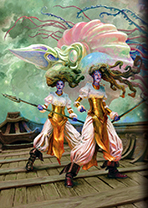 Reigar are androgynous folk who evolved into a humanoid
shape from a species of cephalopods similar
to octopi. They have bioluminescent freckles and
the ability to change the coloration of their skin. A
glory (or halo) surrounds each of them. This magical
display is a cloud of twinkling, glittering motes that
changes color randomly and repels attacks.
Reigar are androgynous folk who evolved into a humanoid
shape from a species of cephalopods similar
to octopi. They have bioluminescent freckles and
the ability to change the coloration of their skin. A
glory (or halo) surrounds each of them. This magical
display is a cloud of twinkling, glittering motes that
changes color randomly and repels attacks.
Reigar don't trust one another, which has been
the case ever since they destroyed their home world
in a war that ended with a cataclysmic event called
the Master Stroke. The planet's destruction was the
culmination of a plot to create the most beautiful
display of carnage the multiverse had ever seen.
Reigar exist solely to make art and wage war. They
consider warfare to be the highest form of artistic
endeavor, and every act of violence they commit is
done with the intent of creating something beautiful.
Reigar wander Wildspace and the Astral Sea in
search of artistic inspiration, traveling in symbiotic
organic ships that they create (see "Esthetic" earlier
in this book). Each reigar possesses a magic item
called a talarith, which it created and to which it
alone can attune. If this object is lost or destroyed,
it takes 1d10+20 days for the reigar to craft
another one.
|
|
|
|
|
March 4, 2023
The Fairy Universe
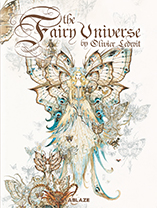 authors: Laurent and Olivier Souillé
authors: Laurent and Olivier Souillé
interior artist: Olivier Ledroit
cover artist: Olivier Ledroit
publisher: Ablaze
publication date: 2022
cover: hardcover
number of pages: 112
ISBN-10: 1-950912-51-5
ISBN-13: 978-1-950912-51-3
description: This artbook contains descriptions of many fairies, elves and fey creatures. It is not associated with any particular role playing game.
Our featured entry from this bestiary is the fairy, Absinthe.
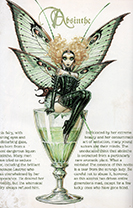 This fairy, with
shining eyes and
a disturbing gaze,
was born from a
most dangerous liquor:
absinthe. Many men
have tried to seduce
her, including the brilliant
Toulouse-Lautrec who
was overwhelmed by her
appearance. He desired her
greedilyr but the whimsical
fairy always refused him.
This fairy, with
shining eyes and
a disturbing gaze,
was born from a
most dangerous liquor:
absinthe. Many men
have tried to seduce
her, including the brilliant
Toulouse-Lautrec who
was overwhelmed by her
appearance. He desired her
greedilyr but the whimsical
fairy always refused him.
lntoxicated by her extreme
beauty and her consummate
art of seduction, many young
suitors lost their minds. The
uneducated think that absinthe
is extracted from a particularly
rare aromatic plant. What a
mistake! The essence of this nectar
is a tear from the strange lady. Be
careful not to abuse it, however,
as this alcohol has driven entire
generations mad, except for a few
lucky ones who have gone blind.
|
|
|
|
|
April 1, 2023
Starfinder Interstellar Species
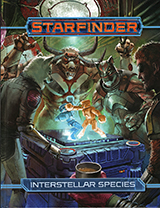 authors: Rigby Bendele et al.
authors: Rigby Bendele et al.
interior artists: Sergio Cosmai et al.
cover artist: Ignacio Bazán Lazcano
publisher: Paizo
publication date: 2022
cover: hardcover
number of pages: 192
ISBN-10: 1-64078-473-X
ISBN-13: 978-1-64078-473-4
description: Chapter 2 of this volume contains 25 in-depth entries describing playable races. Chapter 3 presents forty pages of non-player characters. This work is compatible with the Starfinder Role Playing Game.
Our featured entry from this volume is the astrazoan.
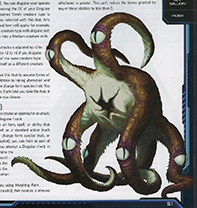 With unclear origins and no home world to call their own,
astrazoans have dispersed throughout the Pact Worlds and
beyond to join the galaxy's cosmopolitan tapestry. However,
astrazoans only rarely show their true forms to non-astrazoans.
Instead, most live their lives as humans, lashuntas, vesk, and
other creatures of the Pact Worlds, preferring a semblance
of anonymity and not wanting to shock their neighbors'
humanoid sensibilities with astrazoans' peculiar appearances.
After centuries of Drift travel and trade, most humanoids are
accustomed to extremely varied life-forms, yet the astrazoan
tradition of polite secrecy persists.
With unclear origins and no home world to call their own,
astrazoans have dispersed throughout the Pact Worlds and
beyond to join the galaxy's cosmopolitan tapestry. However,
astrazoans only rarely show their true forms to non-astrazoans.
Instead, most live their lives as humans, lashuntas, vesk, and
other creatures of the Pact Worlds, preferring a semblance
of anonymity and not wanting to shock their neighbors'
humanoid sensibilities with astrazoans' peculiar appearances.
After centuries of Drift travel and trade, most humanoids are
accustomed to extremely varied life-forms, yet the astrazoan
tradition of polite secrecy persists.
PHYSICAL DESCRIPTION
When an astrazoan lies flat on their belly, they resemble a
radially symmetrical starfish with seven limbs, weighing up
to 180 pounds and having a diameter of 9 feet from the tip
of one limb to the tip of an opposing limb. In practice, an
astrazoan usually walks upright on five limbs, standing about
6 feet tall, with the remaining two limbs reserved to hold and
manipulate objects.
Natural skin color varies, typically being some variant of
dun, orange, or umber. To the touch, an astrazoan's skin is
rough like sandpaper due to its thousands of dermal papillae
that the astrazoan can control to replicate a wide range of
surface textures and colors. Each arm has a large eye embedded
about halfway down its length along the astrazoan's backside.
Individually, an eye provides limited visual data, and an
astrazoan must orient at least four eyes in the same direction to
form a clear image.
The only other distinct feature on an astrazoan's natural body
is its mouth, located at the center of their underside. The mouth
has a small, retractable beak able to tear apart tougher foods;
however, much digestion occurs externally, with an astrazoan
expelling their stomach to envelop their food and secrete
powerful enzymes into the partly chewed meal. Afterward, they
retract the stomach along with the softened food. Like their
stomach, an astrazoan's other organs are also quite mobile, ab1e
to be shunted around the body as needed.
In fact, nearly all of an astrazoan's body can shift, contort,
and invert as needed. The skeleton is cartilaginous and able
to disarticulate temporarily, providing some structure and
considerable fl exibility. Their jellylike flesh is comprised of long
muscle fibers that can dislocate, flow, and realign into new
configurations as needed, allowing them to squeeze through
narrow openings and close wounds with ease. Along with their
dermal papillae and countless chromatophores, an astrazoan can
transform into a variety of functional shapes with extraordinary
precision. Once locked into a new form, involuntary muscles help
maintain the shape, even if an astrazoan become unconscious...
|
|
|
|
|
May 6, 2023
The Encyclopedia of Demons & Devils
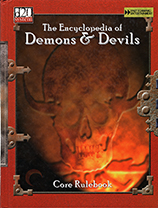 authors: Timothy Brown et al.
authors: Timothy Brown et al.
interior artists: Jack Nichols et al.
cover artist: William W. Connors
publisher: Fast Forward Entertainment
publication date: 2001
cover: hardcover
number of pages: 224
ISBN-10: 0-9713234-3-7
ISBN-13: 978-0-9713234-3-8
catalog number: FAF 2004
description: This book contains entries for 172 tanar'ri (demons) and baatezu (devils). This book is compatible with the d20 Role Playing Game.
Our featured entry from this bestiary is the succubus.
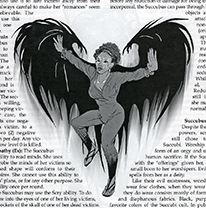 A Succubus is any one of a group of evil demi-goddesses who
are, together, referred to as "the Succubi." Medieval folklore
says that each one of these frightening sisters possesses similar
powers, traits, personality, and appearance. They dwell in
their own dread domain, halfway between nightmares and
reality. Their true names are not known to mortals, and thus
they are all called "Succubus" by those who fear them.
A Succubus is any one of a group of evil demi-goddesses who
are, together, referred to as "the Succubi." Medieval folklore
says that each one of these frightening sisters possesses similar
powers, traits, personality, and appearance. They dwell in
their own dread domain, halfway between nightmares and
reality. Their true names are not known to mortals, and thus
they are all called "Succubus" by those who fear them.
In her demonic form, a Succubus appears to be an extraordinarily
beautiful, naked woman with batwings, fangs, and
blazing eyes. She is seldom seen in this form, though. Usually,
she uses her polymorph self power to appear as a perfectly
formed woman of the same race as her victim.
A Succubus lives to cause dissent among mortals by seducing them, turning them against their friends, family, and gods,
and thus destroying their lives even as she drains away their
life energy. She is an intelligent monster, and very crafty.
Many centuries of practice have made her expert at using her
numerous abilities to their utmost.
Typically, a mortal first encounters a Succubus when entering
her lair (usually underground) or when the demon uses
her telepathic abilities to enter the victim's dreams. The succubus
ranges far at night-sometimes physically, other times
with her mental powers-searching for victims.
Once a succubus encounters a suitable victim, she will use
her limited telepathy to discover the most desirable form to
take to seduce him. She then uses polymorph self to assume a
form that is most pleasing to her victim. Next, she uses .her
telepathic projection power to insert herself into the victim's
dreams. In these dreams, she will always make herself interesting
to the victim - perhaps she is a princess waiting to be
rescued, perhaps a lusty barmaid, perhaps a deposed queen...
|
|
|
|
|
June 3, 2023
The Night Parade of One Hundred Demons: A Field Guide to Japanese Yōkai
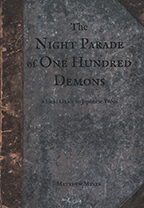 author: Matthew Meyer
author: Matthew Meyer
interior artist Matthew Meyer
cover artists: N.A.
publisher: Matthew Meyer
publication date: 2012
cover: softcover
number of pages: 224
ISBN-10: 0-9852184-2-8
ISBN-13: 978-0-9852184-2-3
description: This book contains over 110 creatures from Japanese folklore.
Our featured entry from this bestiary is the Mikoshi nyūdō.
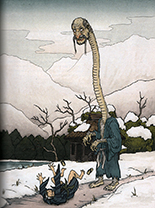 TRANSLATION: anticipating priest
TRANSLATION: anticipating priest
ALTERNATE NAMES: mikoshi, miage nyūdō, takabōzu
HABITAT: bridges, roads, streets; especially at night
DIET: omnivorous; prefers travelers
APPEARANCE: Mikoshi nyūdō are fearsome yōkai who appear late at night to lone travelers on
empty streets, intersections, or bridges. They appear to be harmless traveling priests or monks, no
taller than an ordinary person; but in an instant they grow abnormally tall, with long claws and
hair like a wild beast.
BEHAVIOR: As soon as a person raises his eyes to look upon a mikoshi nyūdō, the giant grows to
an immense height—as tall the observer is able to raise his eyes, and just as fast. This causes the
person to look up so high and fast that they lose their balance and tumble backwards. That's when
the mikoshi nyūdō lunges forward and bites their throat out with its teeth.
INTERACTIONS: Those unfortunate enough to meet this cruel yōkai usually do not live to tell the
tale. Much depends on the person's reaction. If they try to ignore and walk past the mikoshi nyūdō,
the angry giant will crush them or pierce them with bamboo spears and branches. The same fate is
met by those who turn and try to run away. People who stare at the mikoshi nyūdō frozen in fear
will drop dead on the spot, overcome by its presence.
The only possible escape is to anticipate the mikoshi nyūdō (thus its name). Meet it face-to-face,
eye-to-eye, and show no fear. Then, look from its head down to its feet, rather than starting at
the feet and looking up. If done properly, the giant's power to grow will be sapped. Telling the
giant, "You lost! I anticipated your trick!" causes it to vanish in anger, leaving the traveler to pass
safely along.
OTHER FORMS: Mikoshi nyūdō is a popular form of some shape-shifting animals. In particular,
itachi and tanuki transform into these giants in order to hunt humans. Kitsune and mujina are
known to occasionally take this form as well, ~hough less often. When a mikoshi nyūdō is result of
a transformation, it carries a bucket, a lantern, or some other tool. This tool is where the shapeshifter's
true body is stored. If you can snatch the object away from the giant before it attacks, the
spell is broken and the transformed yōkai will be at its captor's mercy.
|
|
|
|
|
July 1, 2023
The Hour of Meeting Evil Spirits: An Encyclopedia of Mononoke and Magic
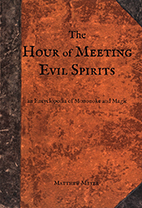 author: Matthew Meyer
author: Matthew Meyer
interior artist Matthew Meyer
cover artists: N.A.
publisher: Matthew Meyer
publication date: 2015
cover: softcover
number of pages: 286
ISBN-10: 0-9852184-3-6
ISBN-13: 978-0-9852184-3-0
description: This book contains over 120 creatures from Japanese folklore.
Our featured entry from this bestiary is the shirime.
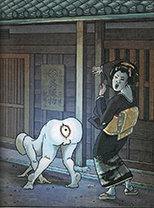 TRANSLATION: butt eye
TRANSLATION: butt eye
ALTERNATE NAMES: nuppori bōzu
HABITAT: city streets, late at night
DIET: none; it just enjoys scaring people
APPEARANCE: From a distance, shirime appear to be normal human beings. When close enough,
however, it becomes apparent that they are yokai. Shirime have no facial features, but located in
their buttholes are large eyes which shine like lightning.
BEHAVIOR: Shirime approach travelers on the road late at night, looking like men wearing a
kimonos. Once they have your attention, they ask if you have a moment to spare. Before you can
answer, the shirime drops its kimono to the ground and bends over, spreading its butt cheeks and
revealing the giant, shining eye located inside of its butthole.
Other than this very startling behavior, shirime do not do anything harmful. They appear to thrive
solely on the joy of scaring people.
ORIGIN: There are few documented encounters with shirime. Because of its alternate name
(nuppori bōzu) and its shocking behavior, it is very likely that shirime are close relatives of the
faceless nopperabō. In that case, a shirime's true form may simply be a shape-shifted animal
playing a practical joke on humans.
|
|
|
|
|
August 5, 2023
The Book of the Hakutaku: A Bestiary of Japanese Monsters
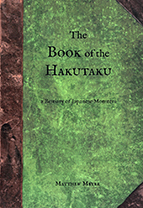 author: Matthew Meyer
author: Matthew Meyer
interior artist Matthew Meyer
cover artists: N.A.
publisher: Matthew Meyer
publication date: 2018
cover: softcover
number of pages: 228
ISBN-10: 0-9852184-5-2
ISBN-13: 978-0-9852184-5-4
description: This book contains over 110 creatures from Japanese folklore.
Our featured entry from this bestiary is the kotobuki.
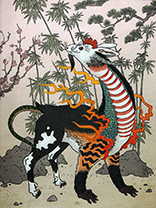 TRANSLATION: congratulations, long life
TRANSLATION: congratulations, long life
ALTERNATE NAMES: jū
HABITAT: unknown; supposedly lives in India
DIET: unknown; likely herbivorous
APPEARANCE: The kotobuki is an auspicious chimerical beast whose body is made up of parts from
the twelve animals of the Chinese zodiac. It has the head of a rat, the ears of a hare, the horns of
an ox, the comb of a rooster, the beard of a sheep, the mane of a horse, the neck of a dragon, the
back of a boar, the shoulders and belly of a tiger, the front legs of a monkey, the rear legs of a dog,
and the tail of a snake. A number of alternate versions exist as well, swapping the body parts for
different zodiacal animals.
ORIGIN: The kotobuki first appeared in the Edo period. Woodblock prints of it were popular
gifts. Little explanation about the creature was included in these prints, other than that it was
said to come from India and could understand human speech. Merely possessing an image of the
kotobuki was believed to protect a person from sickness and disease and bring good fortune to
their home.
Good luck charms featuring the various animals of the zodiac were popular in the Edo period,
especially during the New Year season. While it is traditional to give presents and display
artwork with the new year's zodiac sign on it, an image with all twelve zodiac signs was even
luckier. Even without any explanation, people recognized the twelve zodiac animals hidden
in this beast. Furthermore, the word kotobuki connotes celebration and congratulations. This
made the kotobuki instantly identifiable as a powerful and auspicious creature.
|
|
|
|
|
September 2, 2023
The Fox's Wedding
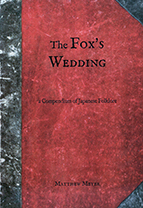 author: Matthew Meyer
author: Matthew Meyer
interior artist Matthew Meyer
cover artists: N.A.
publisher: Matthew Meyer
publication date: 2021
cover: softcover
number of pages: 236
ISBN-10: 0-9852184-5-2
ISBN-13: 978-0-9852184-7-8
description: This book contains over 110 creatures from Japanese folklore.
Our featured entry from this bestiary is the yonaki ishi.
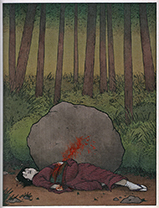 TRANSLATION: night-crying stone
TRANSLATION: night-crying stone
APPEARANCE: Yonaki ishi look like ordinary boulders which cry like babies at night. In many
cases, the stones cry because they are possessed by the vengeful spirit of a murder victim.
However, sometimes it is the stone itself that cries and not a person's spirit haunting it. The most
famous yonaki ishi legend comes from Kakegawa City in Shizuoka Prefecture.
BEHAVIOR: Yonaki ishi imitate the cries of a human baby, attracting people with the sound.
LEGENDS: Long ago, a pregnant woman was walking home through steep mountains. She
reached the Sayo no Nakayama Pass when stopped to rest. Leaning against a large round boulder
to catch her breath, she was suddenly accosted by a bandit. He slashed her belly with his blade
and would have cut through her if his sword hadn't struck the boulder she rested on. The bandit
robbed her and fled back into the woods. The woman bled to death against the boulder.
Because the blade struck the rock, the baby was not injured in the attack. He crawled out from
his mother's body through the wound. Although the mother was dead, her soul was so worried
about her child that it could not pass on. It got stuck in the boulder. From then on, every night
the boulder would cry loudly. A priest from a nearby temple heard the crying. When he went to
investigate, he discovered a newborn baby lying beside the boulder. The priest took the baby back
to his temple and raised him, naming him Otohachi.
When Otohachi grew up he was apprenticed to a sword sharpener. After many years he became
an accomplish sword sharpener as well. One day, a samurai came to Otohachi and ordered him
to repair a chipped katana. Otohachi asked the samurai how such a terrible crack had appeared
in the blade. The samurai casually explained that the blade had been chipped many years earlier
when he had accidentally struck a stone in the Sayo no Nakayama Pass. Otohachi realized
that the samurai was none other than the bandit who murdered his mother. Otohachi stood up,
introduced himself, and then cut down the samurai.
Today, the yonaki ishi is known as one of the Seven Wonders of Shizuoka.
|
|
|
|
|
October 7, 2023
The Dragon Universe
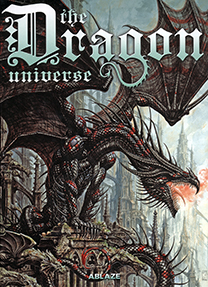 authors: Jean-Baptiste Monge, Pascal Moguérou with Laurent & Olivier Souillé
authors: Jean-Baptiste Monge, Pascal Moguérou with Laurent & Olivier Souillé
interior artists: Jean-Baptiste Monge, Olivier Ledroit et al.
cover artist: Olivier Ledroit
publisher: Ablaze
publication date: 2022
cover: hardcover
number of pages: 200
ISBN-10: 1-950912-50-7
ISBN-13: 978-1-950912-50-6
description: This artbook contains descriptions of many dragons and related creatures. It is not associated with any particular role playing game.
Our featured entry from this bestiary is Mara, the dark girl of rain, and her sluargh companion.
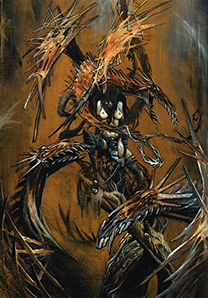 In the Kamalan desert, there had been no rain since Mara was abandoned. Her
mother had died in childbirth, and no one knew who her father was. Lamahetan, the
clan shaman, had cast the runes that evening and they revealed sinister omens. The
council decided that the child had to be removed or else the desert gods would take
offense, and death and disease would fall on the village. Yet Lamahetan opposed the
decision and stood up to the whole council. The runes were bad, but if madness had
taken over the world, it was not about the child, and according to her, the child should
not be abandoned, or she would pay the price one day. The shaman watched over the
child until she was six years old.
In the Kamalan desert, there had been no rain since Mara was abandoned. Her
mother had died in childbirth, and no one knew who her father was. Lamahetan, the
clan shaman, had cast the runes that evening and they revealed sinister omens. The
council decided that the child had to be removed or else the desert gods would take
offense, and death and disease would fall on the village. Yet Lamahetan opposed the
decision and stood up to the whole council. The runes were bad, but if madness had
taken over the world, it was not about the child, and according to her, the child should
not be abandoned, or she would pay the price one day. The shaman watched over the
child until she was six years old.
Unfortunately, old age and the illness eating at her bones took the senior woman
away one evening. In the morning, the village chief saw this as a sinister omen and took
the child to the mountains.
Mara should have died by the sun or the wild beasts, but luck or fate
once again came to her aid. The first few nights were terribly painful.
Mara hunkered down in a cave with terror as her only companion,
jumping at every wild beast's roar that tore through the night.
Luckily, water dripped from the rock at the bottom of the cave,
allowing her to quench her thirst, but it was hunger that forced
her to leave her refuge. The desert does not coddle its children,
but for those who know how to look where they need to, it conceals
many treasures and comes alive at sunset. Lamahetan had shown
it to Mara and despite her young age, the child had not lost a
beat. She had just gotten used to her new environment when
she had a strange encounter ...
A small sluargh with an injured wing and deadly hunger had taken shelter in her
den. Mara's first intention was to kill it for food, but she thought better of it;
the animal was so small, so cute, and seemed quite harmless. Besides,
she felt terribly lonely, and come to think of it, the sluarghs were
intelligent and excellent hunters as well.
Once again, fate turned the wheel in
Mara's favor. The little sluargh recovered
quickly and a real bond and strong attachment
was born between these two very different
beings. Time passed filled with dangers, games,
and hunting. The sluargh had grown enormously
and Mara felt that she might soon be able
to fly on its back.
She knew he would let himself be
ridden the day she wrapped her thin,
muscular thighs around his strong neck. The world would then be theirs.
They would rule heaven and earth, she with her cunning and innate
intelligence as a wild woman, and he with his power and hunting skills.
In all the desert villages, they soon spoke only of the woman with
the sluargh who called herself in a guttural language, "Mara, the
dark girl of rain." She had first started by finding her village and
then landed at nightfall in the middle of the filthy shacks.
The sky had become strangely overcast above her, and
the rain, as if to celebrate her return, began to fall.
The villagers, at first frightened, then incredulous, and
ultimately amazed by this double miracle falling from the
sky, finally approached. They sent for the chief, but his
hut was empty and only Mara was not surprised. The day
before, her sluargh had taken only one bite ...
Since then, Mara reigns alone over the desert,
protected by her most faithful friend and all her
descendants. In all the villages she is revered as a goddess,
she takes what she wants but never more than she needs.
And no more children have been offered to the desert.
Excerpt from "Chronicles of the Old World" by Ourouk el Nasrim
|
|
|
|
|
November 4, 2023
Faries of the Faultines, Expanded Edition
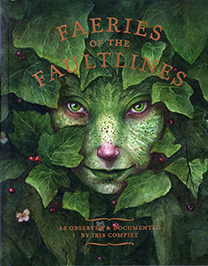 author: Iris Compiet
author: Iris Compiet
interior artist: Iris Compiet
cover artist: Iris Compiet
publisher: Eye of Newt Books
publication date: 2021
cover: harcover
number of pages: 184
ISBN-10: 1-7770817-2-6
ISBN-13: 978-1-7770817-2-0
description: This volume contains descriptions of numerous creatures from around the realm of faerie, including, of course, many varieties of faeries, as well as fauns, mandrakes, witches, trolls, gnomes, hobgoblins, brownies and mermaids.
Our featured entry from this bestiary is a faerie from the discussion of faeries who possess insect-like traits.
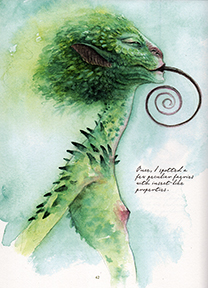 Once,I spotted a few peculiar faeries with insect-like properties.
Once,I spotted a few peculiar faeries with insect-like properties.
Some of the creatures I saw had compound eyes while others had skin covered in tiny scales like the wings of a butterfly. These scales are responsible for their chromatic changes and aid in their protection and insulation. Although their butterfly-like tongues suggested they feed on nectar, I've witnessed some of them using their viscoelastic tongue to feast on other faeries.
|
|
|
|
|
December 2, 2023
Bigby Presents Glory of the Giants
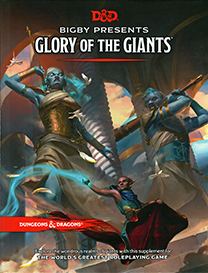 lead designer: James Wyatt
lead designer: James Wyatt
interior artists Carlo Arellano et al.
cover artist: Cynthia Sheppard
publisher: Wizards of the Coast
publication date: 2023
cover: hardcover
number of pages: 192
ISBN-10: 0-7869-6898-2
ISBN-13: 978-0-7869-6898-5
description: Chapter 6 of this book contains over 70 creatures related to giants. This book is compatible with the 5th edition of the Dungeons & Dragons Role Playing Game.
Our featured entry from this bestiary is the death giant shrouded one.
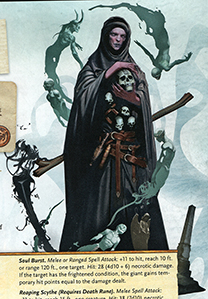 Long ago, a large band of cloud giants traveled to
the Shadowfell in search of a way to preserve their
collapsing empire. Desperate to save themselves
and their way of life, they collectively made a bet
with the Raven Queen, a mysterious god of death
and memory who dwells on that plane. Accounts of
that bet and its outcome vary: some say the Raven
Queen answered every riddle the giants posed until
the giants collapsed from exhaustion, while others
describe a series of increasingly improbable events
favoring the Raven Queen in every wager. What is
certain is that the giants severely underestimated
the Raven Queen. When they lost their wager, the
Shadowfell became their home, and they have
grudgingly served the Raven Queen ever since.
Long ago, a large band of cloud giants traveled to
the Shadowfell in search of a way to preserve their
collapsing empire. Desperate to save themselves
and their way of life, they collectively made a bet
with the Raven Queen, a mysterious god of death
and memory who dwells on that plane. Accounts of
that bet and its outcome vary: some say the Raven
Queen answered every riddle the giants posed until
the giants collapsed from exhaustion, while others
describe a series of increasingly improbable events
favoring the Raven Queen in every wager. What is
certain is that the giants severely underestimated
the Raven Queen. When they lost their wager, the
Shadowfell became their home, and they have
grudgingly served the Raven Queen ever since.
Over time, the Shadowfell transformed these
giants; their bodies shriveled, and their complexions
took on a deep-purple hue. They became the
first death giants, and their descendants haunt the
Shadowfell to this day, searching both that plane
and the Material Plane for souls that might please
their divine queen.
A death giant shrouded one has learned the secrets
of death magic-some say from the Raven Queen
herself. A shrouded one collects the skulls of fallen
kin and inscribes the death rune on a prized skull
from this grisly collection. Abandoning armor in
favor of gloomy robes, the shrouded one uses rune
magic to create a shadowy scythe blade at the end of
a staff and to conjure an aura of tormented souls for
protection.
|
|
|
|
|
Continue to 2024 entries.
|
|
|
|
|
|
|
|

